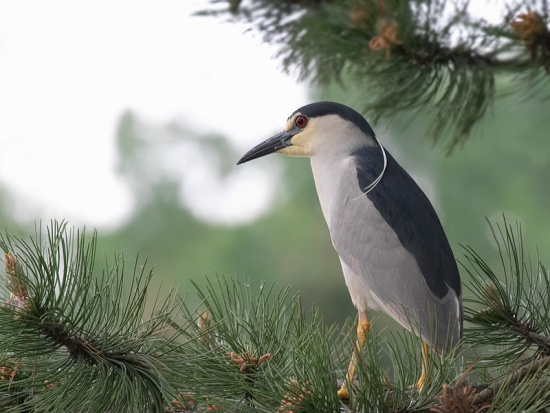(Vocalisation heading) |
|||
| Line 6: | Line 6: | ||
==Identification== | ==Identification== | ||
| + | 64 cm. Black crown and back, remainder of body white or grey, red eyes, and short yellow legs, short-necked and stout . Young birds are brown, flecked with white and grey. | ||
==Distribution== | ==Distribution== | ||
| Line 31: | Line 32: | ||
==Behaviour== | ==Behaviour== | ||
| − | + | Usually crepuscular. | |
| − | ===Vocalisation=== | + | |
| + | It builds a platform of sticks placed in tree or cattails and nests colonially; more than a dozen nests may be in a single tree. 3-5 greenish eggs are laid. | ||
| + | |||
| + | ====Vocalisation==== | ||
<flashmp3>Nycticorax nycticorax (song).mp3</flashmp3><br /> | <flashmp3>Nycticorax nycticorax (song).mp3</flashmp3><br /> | ||
''[[Media:Nycticorax nycticorax (song).mp3|Listen in an external program]]'' | ''[[Media:Nycticorax nycticorax (song).mp3|Listen in an external program]]'' | ||
==External Links== | ==External Links== | ||
{{GSearch|Nycticorax+nycticorax}} | {{GSearch|Nycticorax+nycticorax}} | ||
| − | + | ||
[[Category:Birds]] [[Category:Nycticorax]] [[Category:Bird Songs]] | [[Category:Birds]] [[Category:Nycticorax]] [[Category:Bird Songs]] | ||
Revision as of 13:54, 12 November 2008
| This article is incomplete. This article is missing one or more sections. You can help the BirdForum Opus by expanding it. |
- Nycticorax nycticorax
Identification
64 cm. Black crown and back, remainder of body white or grey, red eyes, and short yellow legs, short-necked and stout . Young birds are brown, flecked with white and grey.
Distribution
North, Central, and South America, Europe, Africa, and Asia.
Americas
Breeds in south-central and south-eastern Canada and over much of the USA except the mountains of the west. Also occurs in the West Indies and from Mexico south to Panama and over most of South America except the higher Andes and Amazonia. Also breeds in the Falkland Islands and Hawaii. Northern birds are migratory and winter in south-west and south-east USA.
Europe
Very patchy breeding range across southern Europe from Iberia to Greece and Turkey, and north to Russia. Isolated breeding population in the Netherlands.
Colony of full-winged, but artificially fed, birds of the nominate race breeds ferally in Norfolk, England and there is a small number of free-flying birds of the North American race based around Edinburgh Zoo, Scotland. Neither of these populations is thought to wander any distance and attempts are underway to reduce the number of free-flying birds in the Scottish population.
There are also colonies in Belgium which are the descendants of released birds. A summer visitor to all but the south-east of the region where resident, overshooting spring migrants regularly seen in Britain (>500 records), usually May-June, more rarely north to Iceland and the Faroes, Norway, Finland, and Estonia. Also recorded on the Azores, Madeira, and Cape Verde Islands.
Asia
In Asia breeds from the Caspian east to China and Japan and south to India and Sri Lanka, Malaya, Borneo and Sumatra.
Africa/Middle East
Widespread in sub-Saharan Africa from Senegal to Somalia and south to the Cape but breeding records are widely scattered. Also small numbers in North-West Africa, the Nile Delta and parts of the Middle East.
Taxonomy
Four subspecies are recognised.
- Nominate race occurs in Europe, Asia and Africa.
- falklandicus in the Falkland Islands
- obscurus in South America
- hoactli occurs in North and Central America and the West Indies (Greater Antilles)
Habitat
Wooded swamps, well-vegetated margins of lakes and rivers. On passage and in winter sometimes in more open habitats, including brackish lagoons and estuaries.
Behaviour
Usually crepuscular.
It builds a platform of sticks placed in tree or cattails and nests colonially; more than a dozen nests may be in a single tree. 3-5 greenish eggs are laid.
Vocalisation
<flashmp3>Nycticorax nycticorax (song).mp3</flashmp3>
Listen in an external program





